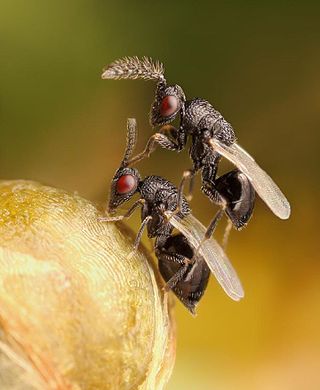
Chalcid wasps are insects within the superfamily Chalcidoidea, part of the order Hymenoptera. The superfamily contains some 22,500 known species, and an estimated total diversity of more than 500,000 species, meaning the vast majority have yet to be discovered and described. The name "chalcid" is often confused with the name "chalcidid", though the latter refers strictly to one constituent family, the Chalcididae, rather than the superfamily as a whole; accordingly, most recent publications (e.g.,) use the name "chalcidoid" when referring to members of the superfamily.

Eupelmidae is a family of parasitic wasps in the superfamily Chalcidoidea. The larvae of the majority are primary parasitoids, commonly on beetle larvae, though many other hosts are attacked, including spiders. Details of the life history varies considerably. They are found throughout the world in virtually all habitats.

The Eurytomidae are a family within the superfamily Chalcidoidea.

The Ormyridae are a small family of parasitic wasps in the superfamily Chalcidoidea. They are either parasitoids or hyperparasitoids on gall-forming insects, primarily cynipid wasps and tephritid flies. The 120 or so species are cosmopolitan, except almost entirely absent from South America.
Baeoentedon is a genus of hymenopteran insects of the family Eulophidae, they are parasitoids of whitefly from the family Aleyrodidae which are found on trees of the genus Ficus. They have been recorded from Australia, China, India, Indonesia and Florida. A fifth species, Baeoentodon farazi, was described from Karnataka, India, in 2017.

Chrysonotomyia is a genus of small parasitoid wasps in the family Eulophidae, with over 170 described species. Members of the genus tend to attack insect larvae that feed within living plant tissue, such as gall-formers, leaf-miners and stem-miners. The Neotropics contain most described species. Within the region, most attack galls induced by Cecidomyiidae midges, although there are also records from Torymidae galls, Cynipidae galls, Psyllidae galls, Momphidae leaf mines and scale insects in the family Coccidae.

Ablerus is the only genus in the family Azotidae. The genus was created by the American entomologist Leland Ossian Howard in 1894 for the species named in that year by William Harris Ashmead as Centrodora clisiocampae. The genus Azotus was synonymized with Ablerus by Alexandre Arsène Girault in 1913 and Hyatt synonymized Myocnemella with Ablerus in 1994, leaving Ablerus as the sole genus within the subfamily Azotinae. Azotinae was elevated in rank in 2013 to become the monotypic family Azotidae.

Heydenia is a genus of wasps in the family Heydeniidae. They are parasitoids of bark beetles.

Megastigmus is a genus of minute wasps. There are more than 134 described species, more than half of which undergo larval development within the seeds of trees and shrubs.

Cleonymus is a genus of wasps in the family Cleonymidae. There are more than 40 described species in the genus, which has been recorded on every continent except Antarctica.
Austroencyrtus is a genus of parasitic wasps.

Psyllaephagus is a genus of chalcid wasps. It was named and circumscribed by William Harris Ashmead in 1900. As of 2019, Psyllaephagus contains approximately 245 species. They are found worldwide: Australia has 100 described species; the Palaearctic region has about 57 species, India has about 20, and Africa about 30.
Parachalcerinys is a genus of wasp. As of 2018, three species are recognized, which are all found in Australia.
Callitula is a genus of insects belonging to the family Pteromalidae.
Muscidifurax is a genus of parasitoid wasps belonging to the family Pteromalidae.
Marina Dmitrievna Zerova was a Ukrainian entomologist. Several insects have been named after her. She became Doctor of Biological Sciences (1980), Professor (1989) and Honored Worker of Science and Technology of Ukraine (2003). In 1981 she was awarded the Award of the National Academy of Sciences of Ukraine named after DK Zabolotny.
Plutarchia is a genus of chalcid wasp in the subfamily Eurytominae. Alexandre Arsène Girault first circumscribed the genus in 1925; its name honors Plutarch. The genus initially only comprised its type species, P. bicarinativentris, found in Australia. Subsequent species from South Asia and Nigeria have been described and transferred to Plutarchia.
Anastatus disparis is a species of wasp, and an egg parasitoid. Hosts include Lymantria dispar and Antheraea pernyi. The species is sexually dimorphic, with 630 sex specific genes. Females have 11 antennal subsegments, whereas males have 8. Females only mate once, and males are significantly shorter lived than females, engaging in agonistic behavior.

Anastatus japonicus is a species of parasitic wasp in the family Eupelmidae. It is an egg parasitoid and will parasitize various forestry and agricultural pests such as the brown marmorated stink bug. The species is widespread and can be found in most countries north of the Equator.











